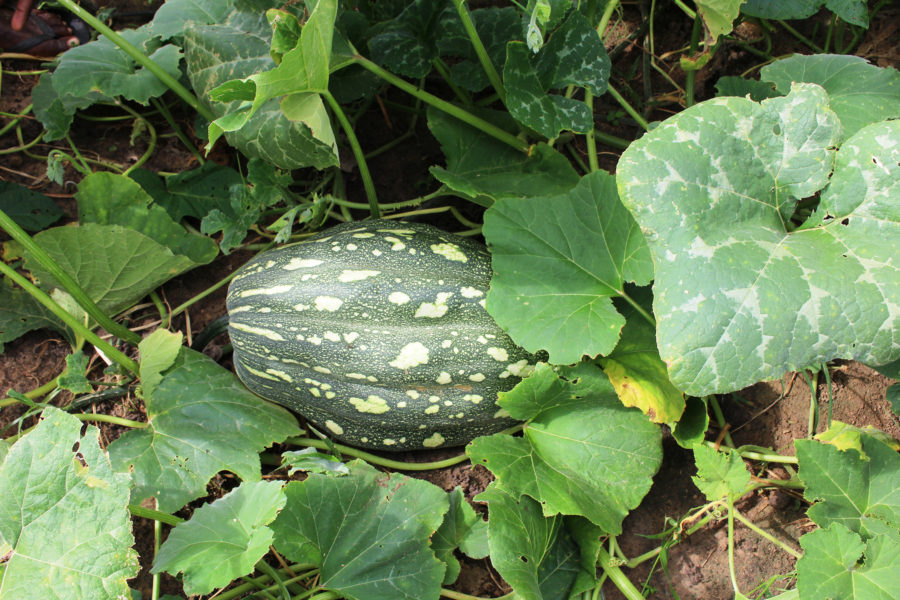(Continued from last week)
Photos by Joanna Dhanraj
The only word to describe the village garden is lush. Vegetable plants spill out of their designated beds, the produce is large. I could barely find a pathway through the plants.
Wherever I looked, a scene of beautiful greenery greeted me. Following Lonsford Rodney, who parted the plants as we went along, I came across some of the biggest boulangers ever seen, pumpkins and watermelons larger but covered by leaves and plants around. In another row there were celery and parsley, and in others: calaloo, scallions, pepper, okro, bora, black eye peas and lettuce. Two women fervently worked battling the afternoon sun and using their hoes to clear weeds from the beds. Rodney pointed out that all plants were organic as use neither fertilizers nor weedicides; the rich soil takes care of the nutrients. Noticing a number of Gerbera flowers among the plants, I asked the reason for their dispersal and was told that Gerbera attracts insects and would keep them away from the vegetables.
Opposite the Kwatamang Sports Complex lives former senior councillor Norbert Salty and his extended family. Salty was senior councillor from 2004 to 2006.
He clearly recalled what Kwatamang was like decades ago; not much has changed. “The structures were mostly thatched roofs and mud walls. We hadn’t so many houses either. Even our school was thatched (troolie) roof and mud walls; the mud walls went halfway up and we had concrete floors. I used to go to that school. We were more culturally [inclined] at the time. Our houses used to be closer and we shared a lot of food and drink among ourselves. We worked together hunting, farming and fishing,” he said.
And though life hasn’t changed much, people are now more independent. The houses are mostly made of clay bricks with zinc sheet roofs; very few houses still carry a thatched roof.
Now with the rainy season approaching, the fish are leaving the rivers and swimming up the creeks. “… We call this fish marching,” Salty said. “The small creeks run through the savannahs and they go there to lay their eggs. This is the time when we catch fish. Sometimes you walking in creeks and you mashing them.”
Archery is a strong point for many Macushis and Salty is no different. “I started catching fish with the fishing rod but learnt to use the arrow and bow when I was eight on our farm in Annai backdam. My father made me some arrows and taught me how to use them to hunt and fish,” the skilled archer reminisced.
He told of a time while he was still a teenager when the white-lip peccaries (bush hogs) would come through the forest in herds into the village. The older men, he said, had a ball picking them off, using their arrows, spears and draw points (an arrow with two points).
Hunting has changed, Salty said, adding that chainsaws and other machines have scared the animals away from their habitats and now instead of awaiting the herds, they have to go in search of one or two single bush hogs.
At 33, Salty is one of the most accomplished residents of Kwatamang. He became a senior councillor at 19 and served one term. He later completed computer courses at Global Technology, received hands-on training for Radio and Script Writing at the National Communications Network, participated in a media workshop presented by Dr Rovin Deodat and was the only person to have been selected from North Rupununi to attend a one-week media workshop in Ghana through a UNESCO sponsorship. These are just a few on his list of accomplishments. He is currently a tutor at the Bina Hill Institute teaching Information Technology.
Salty, who is also in charge of sports in Kwatamang said that the youths of North Rupununi are going places. “Our girls recently reached the finals this year bringing second to the GDF females [at football] while Orville Daniels who played for the Paiwomak Warriors [North Rupununi Football Team] is now playing for the Golden Jaguars under-17 and scored a goal against Haiti earlier this year in a winning match,” he said proudly.
As regards improvements, he indicated that Kwatamang would be grateful for better roads, and electricity since residents source their lights from solar panels or generators.
For Easter, he planned to enjoy a variety of dishes and go kite flying with his children at the ground nearby. “We have no plans for Easter with most of the persons out of the village for a church conference. However, we’ll be flying our kites in the cricket ground,” he said.
“We plan on making roast chicken, tuma pot with farine… I told my wife it’s a long time since I had chicken curry; since I was in Georgetown in fact, so we will be making chicken curry and chow mien.”
I had been told about rattlesnakes and asked Salty about this.
“We have rattlesnakes here,” he confirmed. “Only recently I killed a large one with my foise [a Macushi word for a tool similar to a cutlass but with a long handle]. It was right outside the kitchen. I lost my brother to one, years ago. He was four or five at the time. He came screaming into the house and when we went out, there was the snake curled up just outside. He was bitten around seven that morning and we took him to the Annai Health Centre two miles away on bicycle, then to the hospital, where he died the same day around four.”
He believes that if there had been emergency planes like there are now, his brother may have lived.
Dusk was fast approaching and it was time to head back to Annai. Rodney took me back to the Winters’ house where I had left the bicycle and I began the journey back with thoughts of rattlesnakes still fresh in my head.
It is one thing to climb a hill on a bicycle; it is quite another to descend it, but I had to make it back before dark in time to pack and catch the bus back to Georgetown. I was in a hurry. Speeding downhill, I noticed something green in the red dirt out of the corner of my eye. When my brakes finally did work and I came to a stop, I turned around and head back to see just what I suspected, a snake.
More than two feet in length, it lay in the middle of the road. (Google later revealed it to be a parrot snake.) I stood watching it from a distance and though it didn’t move, it looked very alive. I threw some pebbles at it hoping it would slither off, but the stubborn reptile barely shifted a few inches. It was not going anywhere, but I had to leave and so mounting the bicycle again I sped off.



















